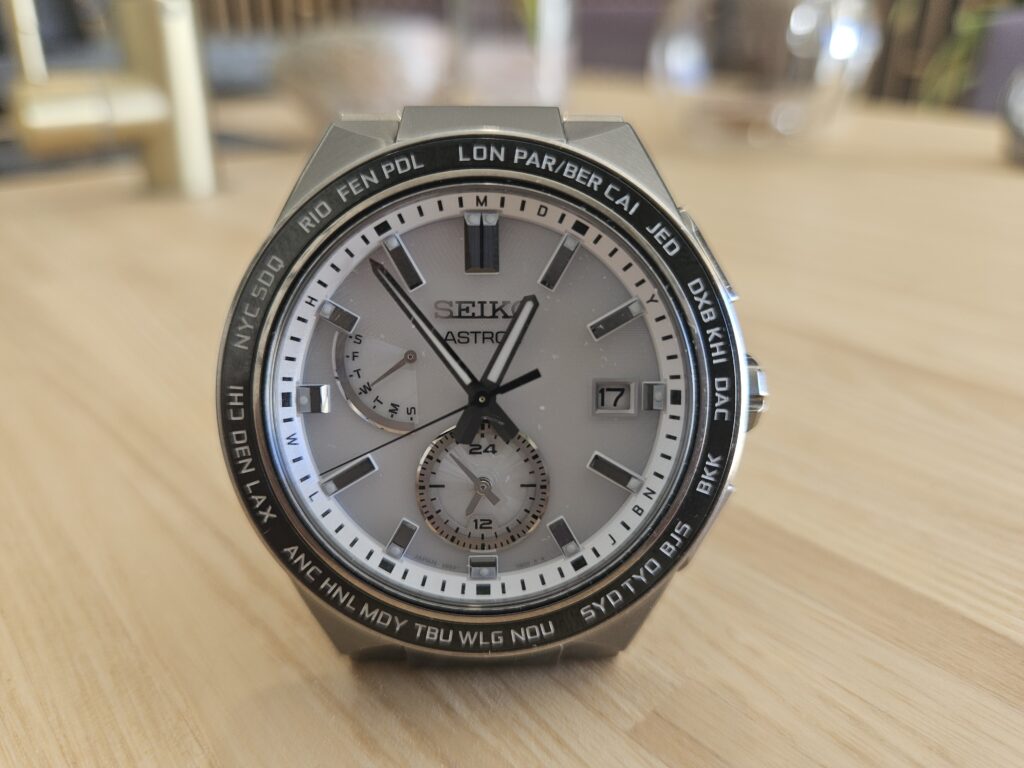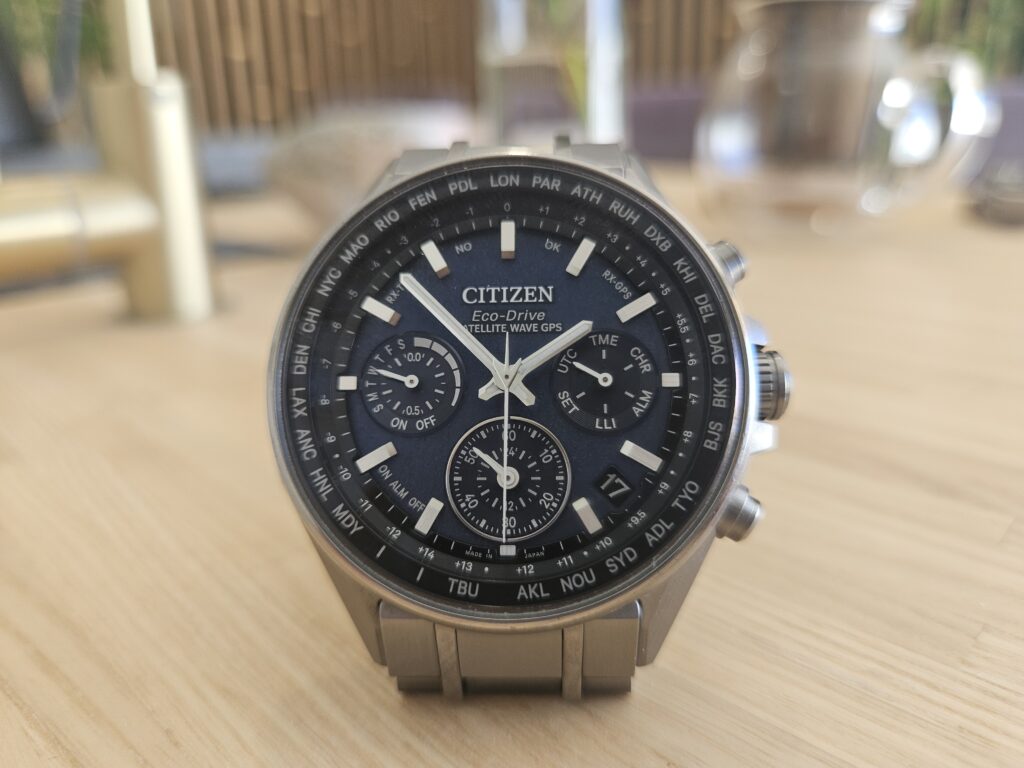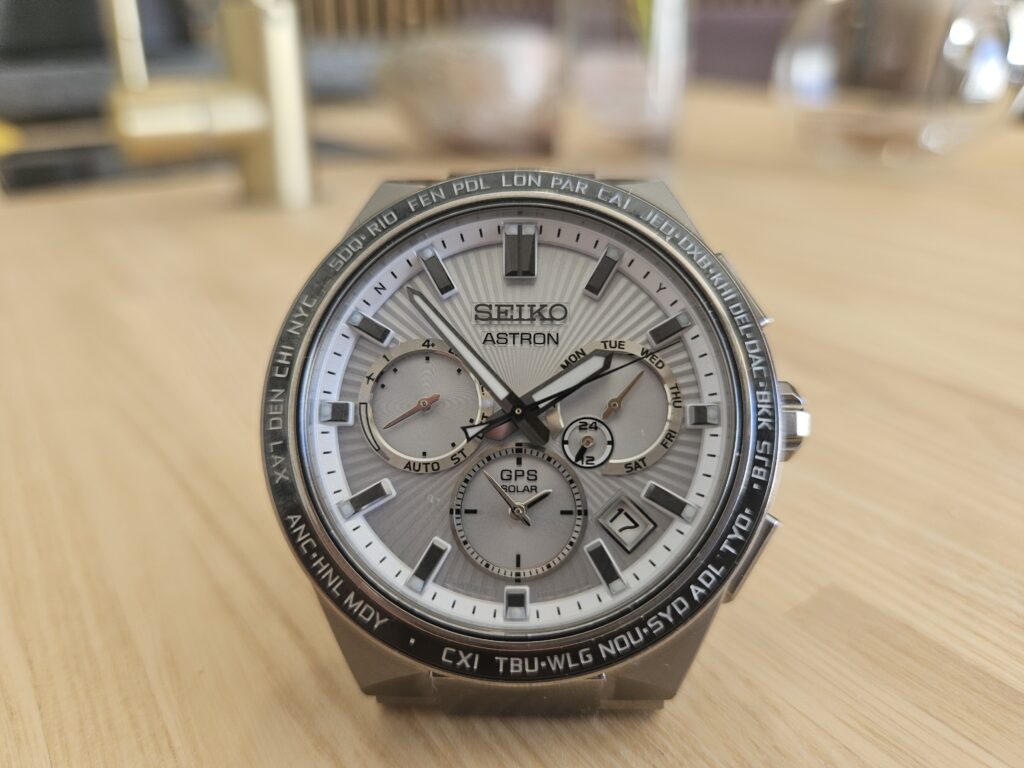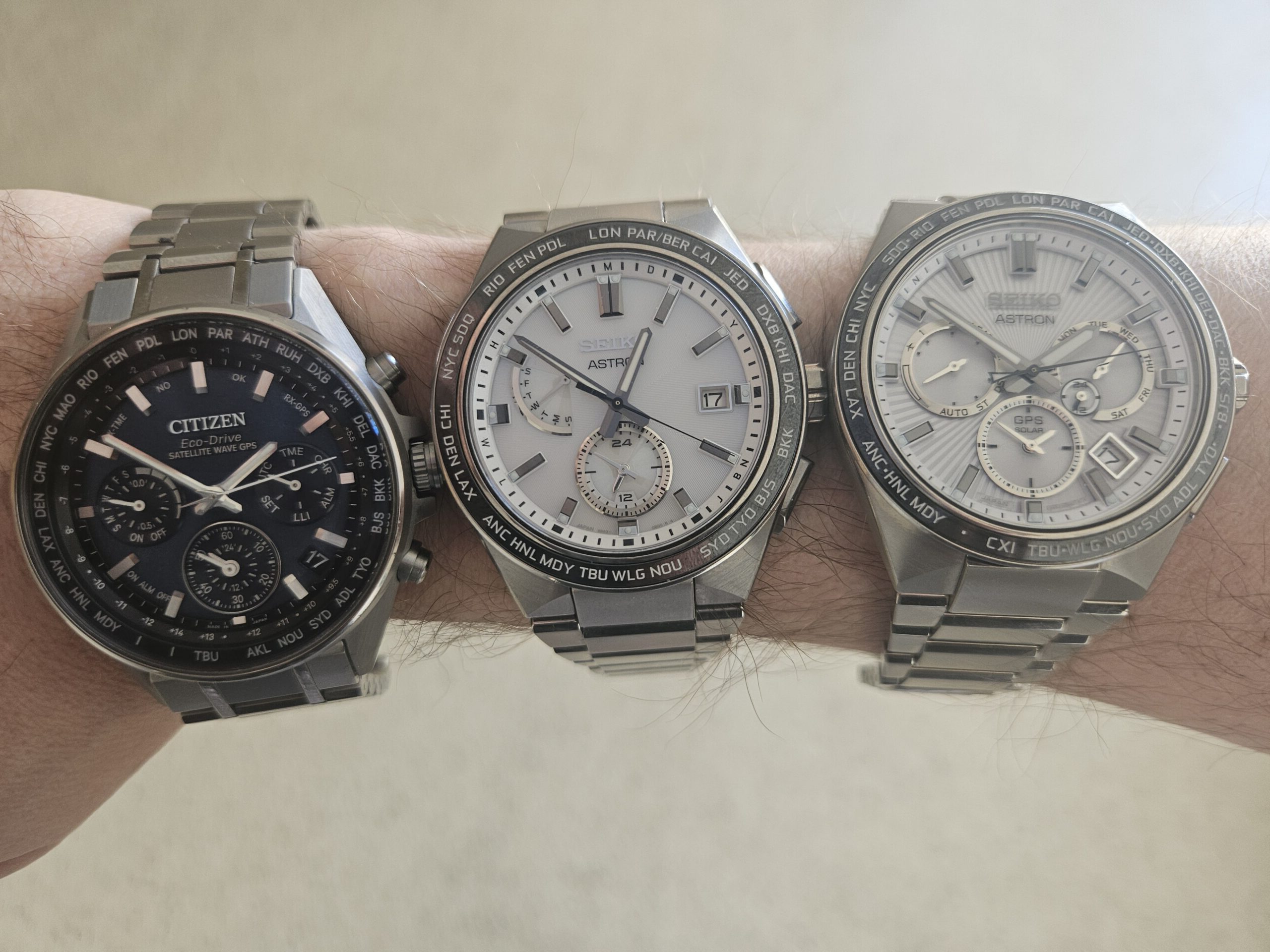Last year I went on a lot of cruises which took me to remote places. As I always do when I travel, I wore my trusty Breitling Transocean Unitime. I bought the watch eight years ago because, at the time, it was the only mechanical watch that I could find that had all of the time zones (world time) AND you could switch between them with single “clicks” of the crown. No need to swing the minute hand around to find the right time. But on my cruise I ran into a limitation of the watch: it couldn’t do the weird half-hour timezones like those found in Adelaide or St. Johns, Newfoundland. This was just enough of an inconvenience for me to go deep and see if a better travel watch might exist.
I thought about not writing about this until next year’s gear post, but I want people to understand how deeply I research to find the right items. Sometimes when I read other people’s gear posts I get frustrated because they’ve obviously just chosen something that’s “good enough”, and then written about it like it was the best. I’ve made that mistake in the past (I recommended the wrong all-in-one USB cable, for example), but I generally do enough research that it doesn’t happen.
As I always do when looking for gear, I decide what matters most to me and search as widely as possible (by the way, this is also how I decided who to marry, where to live, and which house to buy). Here were my criteria:
- It must be totally self powered. I hate having to keep track of charging things while traveling and I don’t want to have to go find a new battery on the other side of the world. This eliminates any smartwatch. I did consider some of the high end solar Garmin watches, because they have really good battery life, but they are absolutely enormous.
- It must be very easy to tell the time where I am and at home, and possible to tell the time elsewhere. The Breitling allows you to tell the time anywhere at a glance… but that glance is really more of a scan and stare because the names of the places are so small. I found that I used that feature less than I expected.
- It should be lighter than the Breitling. I have small girly wrists, so the Breitling really hangs and I feel it. It also looks a bit too big.
- Ideally it would look decent. I don’t need the most beautiful watch in the world, but it is something I look at dozens of times a day, and when traveling lightly I aspire for my gear to work in a range between informal and formal.
At first I gravitated towards automatic self-winding watches. They’re totally self powered and I love the craftsmanship of them. There are a lot of good GMT watches (two time zones at once), but nothing that seemed to be a big improvement over the Breitling. I looked at every smart watch, and none of them had long enough battery life. I think I would be willing to charge once every 90 days, since I never travel for that long.
My friend Todd has a Seiko solar digital watch that sets itself over radio. It was just ugly enough that I wouldn’t consider it (sorry, Todd), and I prefer analog watches, but I went down that rabbit hole as well and searched to see if any looked okay, mainly because the functionality is so good.
As I was searching through these digital watches, I learned that Seiko made analog solar radio watches as well. Wow! I looked at every single model, most of which I found to be overdesigned and ugly. I also learned that some of them could set themselves over GPS instead of radio. At the time I thought I preferred radio, especially because the radio watches were a bit thinner, so I focused on those.
Seiko Astron Radio Watches

Confusingly, Seiko calls both its GPS and radio watches Astrons. At first I thought that all Astrons could do both, but it turns out that they can only do one or the other. These watches are only sold in Japan, so I went to a Seiko watch store in Tokyo to look at them. They actually looked a lot better than they did online.
The best Seiko Astron Radio watches use the 8B63 calibre movement. It’s solar powered, has a day of the week display, a date display, and also a 24 hour dual time display. I looked at all of them and bought the SBXY049 because I thought it looked the best. I liked that it had the names of the cities on the bezel rather than the UTC offsets that some have, and the dial looked less cluttered than a GPS one.
While I was in Tokyo it worked great. Every night at 2am, 3am, and 4am, it would try to set itself by radio. The signal is better at night, but still tough to catch, so it tries three times. In the morning you can press one button and the second hand will swing to the tiny Y or N on the dial under the 2 or 4 hour marker to tell you whether it was successful. It was fun to check every morning to see if it had set itself. Most mornings it had.
The titanium made it feel very light on the wrist and I thought it looked good. Not as good as a Rolex, but good enough. There are radio signals in Japan, China, the US, and most of Europe, so I figured that even if it couldn’t set itself every night while I was on a cruise or something, it would set itself frequently enough based on my travel patterns.
Accuracy was another downside of mechanical watches. I wear a Rolex in Vegas because I like how it looks and it’s very light and comfortable, and the Breitling when I travel. Because one would necessarily sit on a winder for weeks or months at a time, it would gradually drift by a few seconds and even by minutes eventually. I wouldn’t reset it unless it was noticeably off, but I never trusted it to be totally accurate.
When I got home to Vegas, though, the Seiko wouldn’t set itself! I have five radio clocks above my desk and they set almost every night, but I couldn’t get the Seiko to set itself anywhere in my house. I used a phone app to broadcast the US timecode locally and it did set to that, so the watch wasn’t defective. Maybe it’s because Vegas is in a valley and the watch is too weak to pick up the signal.
Either way, it was too annoying to be my new watch. The radio Seikos also can’t do fractional time zones, which I was hoping to have covered.
Citizen GPS Watches

Next I looked into Citizen GPS watches. They are much cheaper than the Seiko ones and have more functionality. They have a stopwatch feature, an alarm, and even a light meter. In my testing they set the location about 30-40 seconds faster than the Seiko, even though a simple time sync is about the same.
They have three movements, the F900, F950, and F990. The F900 is almost the same as the F950. The F990 is the newest but every watch made with it is huge and ridiculous, so I got one with the F950. Most were ugly, but I liked the one I chose which had a dark blue dial and both the city names and UTC offsets around the dial.
GPS watches have two ways to sync. They can get the time from just one satellite, or they can get their position and time from four or more satellites. If they get their position, they use it to set the time zone and time, though you sometimes have to manually choose whether you are observing daylight savings time or not.
The Citizen has the best reception of any watch I tested. With one button press it found its location and set the zone and time from within my office, away from the window. I was blown away at how well it worked, especially compared to the Seiko radio watch which couldn’t set from my office.
The basic functions like setting the watch, swapping the second time zone subdial with the main one, and getting location were easy, but setting alarms and daylight savings were complicated enough that I kept referring to the manual.
For someone with a larger wrist, the Citizen is probably the best choice. It works flawlessly, gets the best reception, and has every feature you’d want.
However, I have a small wrist, and even though it was light due to the titanium, it looked a bit big. So I started researching the Seiko GPS watches.
Seiko GPS Watches

Seiko has four main movements the 8X53, 5X53, 3X62, and 5X83. Easy to remember, right?
The 3X62 is perhaps the most elegant. It only shows one time zone and date so it really looks just like a normal analog watch, but it can set itself automatically just like the rest of them. It looks the best, but despite being less complicated, it’s still almost the same size as the other options. If you didn’t travel much and cared more about what your watch looked like, this would be a great choice. I think they have the best designs of all Seiko Astrons.
The 8X53 is the older version of the 5X53. It does the same stuff but it’s bigger and slower to move the hands. I found all of the 8X53 designs to be ugly, but if you had a bigger wrist and wanted to save some money, maybe that’s a reason to buy one. Ironically the SBXB123 is the cheapest 8X53 and I think it’s the best looking.
The 5X83 is the newest one, only out for a couple months. It is the same as the 5X53 but it moves the hands even faster and has a stopwatch. I found the designs to all be pretty ugly, and even worse it was bigger than the 5X53.
The 5X53 is the one I chose. It is the smallest and thinnest, and while it doesn’t have a stopwatch, it does have day of week, date, and a 12 hour second time with an AM/PM indicator. The Citizen had a 24 hour second time zone, which wasn’t as easy to read because of its tiny size.
I bought the SBXC117, which I think is the best looking of the options. From a distance it looks identical to the Seiko radio watch I bought, so I guess you could say I have a type. I almost bought the SBXC149, a limited edition Japan Airlines watch. For the AM/PM indicator it has a tiny spinning airplane, which I love, but I decided I’d prefer a neutral metal colored watch versus a black one.
The 5X53 is the best watch for me. It’s almost the same size as the radio version, and feels noticeably smaller than the Citizen, at least on my small wrist. It doesn’t look quite as good as the radio one, but still looks very good. I couldn’t get it to sync GPS from my office, but it easily does it outside and can sometimes get time from the office. Both the Citizen and Seiko will wait until they see bright light (sunlight) and will try to sync automatically. I think I go outdoors enough that the watch should stay in sync.
I particularly like the 12 hour home time zone subdial. It makes it much easier to glance and see what time it is back home versus the 24 hour one on the Citizen.
Are GPS Watches the New Mechanical Watches?
I’ve had a mechanical watch for over twenty years. What I love about them is the ingenuity. It’s incredible to me that watchmakers in the 1700s figured out how to make a totally self contained device that required no outside power but could keep accurate time.
And now… isn’t that what a GPS watch is? If those watchmakers in the 1700s had access to our technology, wouldn’t they use every environmental force (solar, GPS, radio, etc) to make the most accurate watch possible? I still absolutely love mechanical watches and will wear one when I’m not traveling, but in my mind these GPS watches are a continuation of the same principles.
GPS watches can do even fractional time zones where they are offset by partial hours, and they support 39 time zones around the world. They also keep a perpetual calendar and will skip days that don’t exist, like February 30th. Mechanical watches tend not to do this, so I found that I never trusted the date on my watch because I wasn’t sure if I had set it or not.
Buying a GPS or Radio Watch
Annoyingly, these watches are only available in Japan! Even if you order online, the chance you’re getting it from Japan is very high. I bought two on Chrono24.com and one on Ebay. Despite being intended for the Japanese market, they work perfectly in the US and manuals are available in English. If you order from Japan and the watch is over $600 (which they all are), your package will be delayed and you may have to pay extra taxes.
If you’re in Japan and can buy the watch tax-free, you may as well buy a new one. The prices are almost identical to used prices for the newer models.
If you’re interested in my Seiko radio watch, Citizen GPS watch, or Breitling, email me and I’ll give you a good price.
More Watch Information
I’m trying to include a lot of information here because it was very difficult to get comparisons between these watches, and I probably wouldn’t have had to buy three if I had more information.
The way all three watches handle power is ingenious. If they don’t see light for a few days they go into sleep mode and use very little power. Once they see light again they spring back into action. With regular use they can all last for months or years without being charged. Once they get low, the seconds hand starts showing the time in two second or five second increments to indicate to you that the battery is low. I think that’s really clever.
Both GPS watches show power reserve. Seiko shows it at all times, Citizen shows it when you press a button. In reality you never actually need to know what it is since they only need a few minutes of charging per day.
Citizen has another mode that sets the second time zone to UTC. I don’t know if I’d ever use this, but it’s neat. In general the design philosophy of the Citizen seems to be maximum functionality, and Seiko seems to be elegance and simplicity.
While searching for the time zone, Seiko moves the second hand to the number of satellites it is locked on. It’s really fun to watch this, and it gives you a better indicator of whether or not it’s going to work. That said, the Citizen seems to be better at finding satellites.
The solar panels are hidden behind the dial, which lets some light through. Unlike digital solar watches, there is no way to visual indication that these are solar powered. Before getting one I assumed that if I looked closely I’d be able to see what part of the watch was actually a solar panel.
The finish of the Seiko dials is very good. It’s rumored that they are made in the same factory as Grand Seiko dials. The Citizen is also very good, but doesn’t have texture on the dial.
On both GPS watches you can press both buttons at the same time and it will swap the main and “home” time zone. I’m not sure when this would actually be useful, but it is fun to watch. On the Citizen it makes a quiet beeping noise while doing it, which I didn’t like.
All three have a neat feature with their clasps where you can adjust by small amounts without having to remove links.
You can also switch time zones manually with easy clicks. In fact, you could easily never use the GPS time zone finding feature and just manually switch every time you get on a plane. I was initially worried that I would be fighting my watch when I was on a cruise because sometimes in the middle of the ocean the ship will be on its own made-up time zone. In reality neither watch will change your time zone without you doing it manually or telling it to do it automatically.
###
Photo is all three watches on my wrist. Big high five to anyone who knows why I took that particular photo.
I might make a YouTube video about these watches, so please leave any questions in the comments. I searched for info on YouTube and there wasn’t much, except random stuff from watch dealers.

Leave a Reply